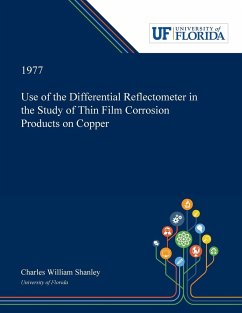
Fiber-Optic Temperature Sensor Using a Thin-Film Fabry-Perot Interferometer
Versandkostenfrei!
Versandfertig in über 4 Wochen
24,99 €
inkl. MwSt.
Weitere Ausgaben:

PAYBACK Punkte
12 °P sammeln!
A fiber-optic temperature sensor was developed that is rugged, compact, stable, and can be inexpensively fabricated. This thin-film interferometric temperature sensor was shown to be capable of providing a +/- 2 C accuracy over the range of -55 to 275 C, throughout a 5000 hr operating life. A temperature-sensitive thin-film Fabry-Perot interferometer can be deposited directly onto the end of a multimode optical fiber. This batch-fabricatable sensor can be manufactured at a much lower cost than can a presently available sensor, which requires the mechanical attachment of a Fabry-Perot interfero...
A fiber-optic temperature sensor was developed that is rugged, compact, stable, and can be inexpensively fabricated. This thin-film interferometric temperature sensor was shown to be capable of providing a +/- 2 C accuracy over the range of -55 to 275 C, throughout a 5000 hr operating life. A temperature-sensitive thin-film Fabry-Perot interferometer can be deposited directly onto the end of a multimode optical fiber. This batch-fabricatable sensor can be manufactured at a much lower cost than can a presently available sensor, which requires the mechanical attachment of a Fabry-Perot interferometer to a fiber. The principal disadvantage of the thin-film sensor is its inherent instability, due to the low processing temperatures that must be used to prevent degradation of the optical fiber's buffer coating. The design of the stable thin-film temperature sensor considered the potential sources of both short and long term drifts. The temperature- sensitive Fabry-Perot interferometer was a silicon film with a thickness of approx. 2 microns. A laser-annealing process was developed which crystallized the silicon film without damaging the optical fiber. The silicon film was encapsulated with a thin layer of Si3N4 over coated with aluminum. Crystallization of the silicon and its encapsulation with a highly stable, impermeable thin-film structure were essential steps in producing a sensor with the required long-term stability. This work has been selected by scholars as being culturally important, and is part of the knowledge base of civilization as we know it. This work was reproduced from the original artifact, and remains as true to the original work as possible. Therefore, you will see the original copyright references, library stamps (as most of these works have been housed in our most important libraries around the world), and other notations in the work. This work is in the public domain in the United States of America, and possibly other nations. Within the United States, you may freely copy and distribute this work, as no entity (individual or corporate) has a copyright on the body of the work. As a reproduction of a historical artifact, this work may contain missing or blurred pages, poor pictures, errant marks, etc. Scholars believe, and we concur, that this work is important enough to be preserved, reproduced, and made generally available to the public. We appreciate your support of the preservation process, and thank you for being an important part of keeping this knowledge alive and relevant.












